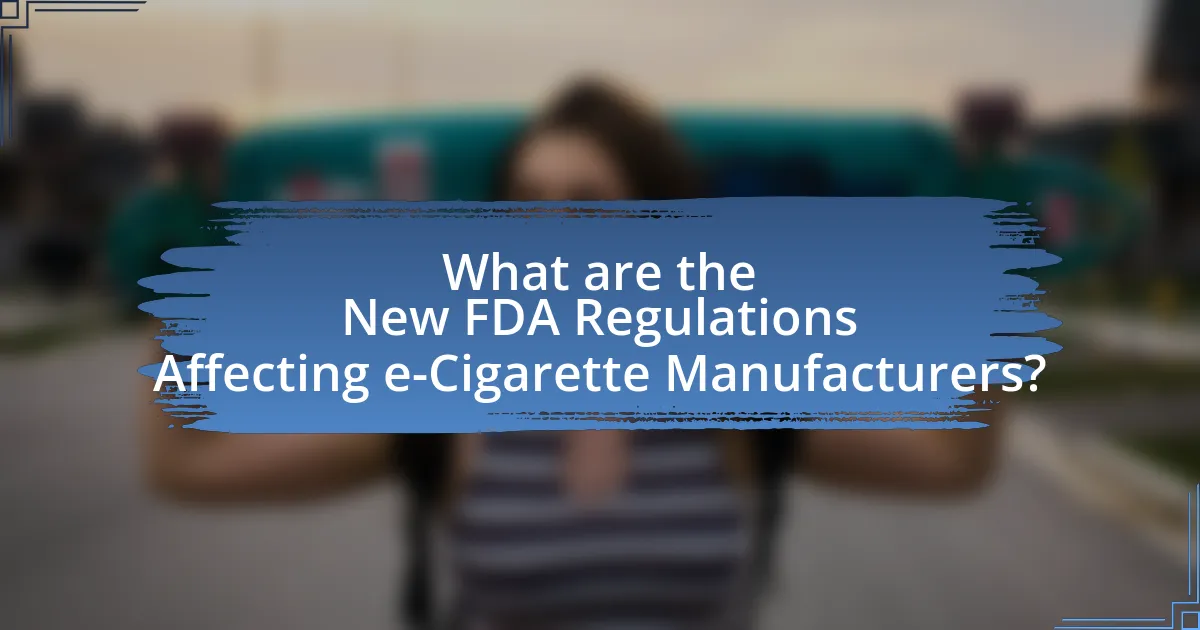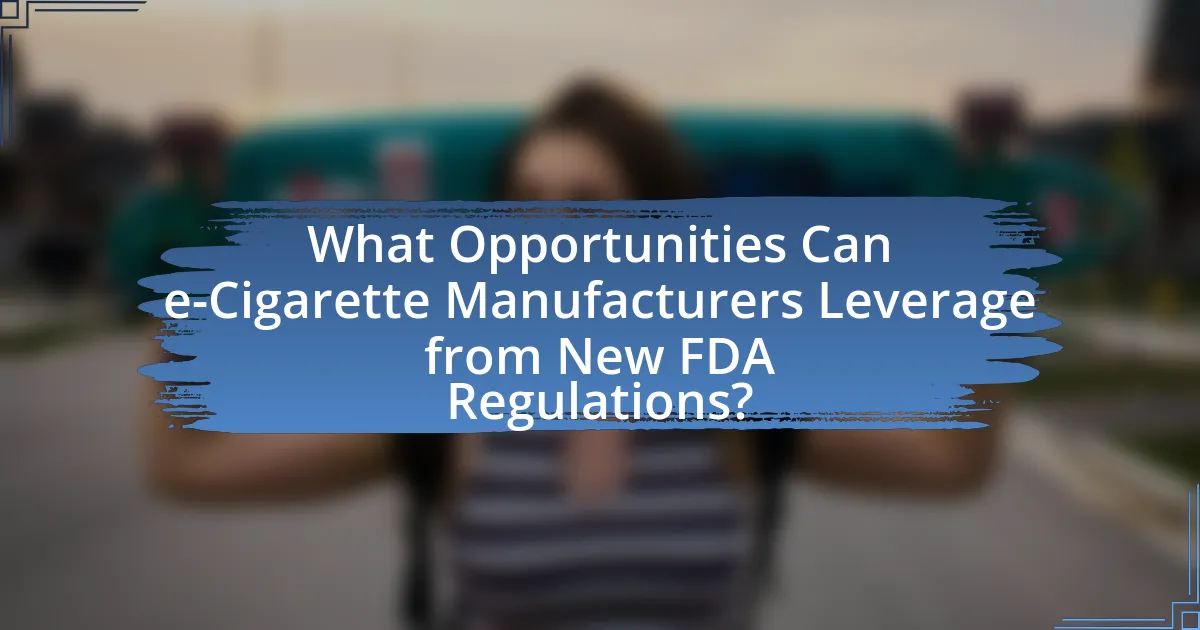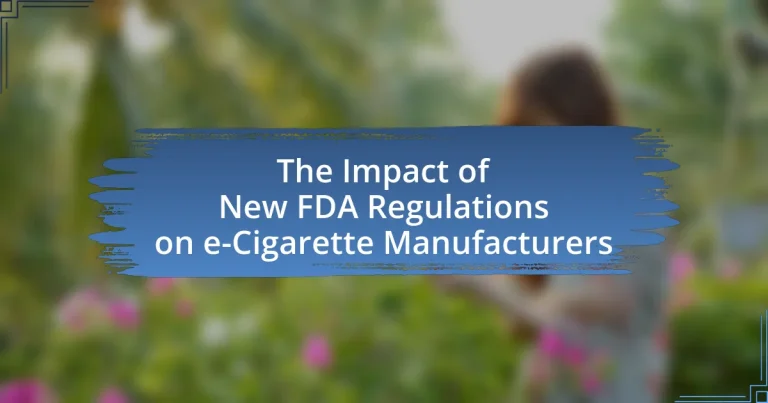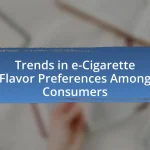The article focuses on the new FDA regulations impacting e-cigarette manufacturers, highlighting the stricter requirements for premarket tobacco product applications (PMTAs) and the limitations on marketing aimed at youth. It discusses how these regulations alter the competitive landscape, impose significant compliance costs, and challenge product development and innovation within the industry. Additionally, the article examines the health concerns that prompted these regulations, the operational challenges manufacturers face, and the opportunities for those who can leverage compliance as a competitive advantage. Key strategies for navigating these regulations and ensuring ongoing compliance and innovation are also outlined.

What are the New FDA Regulations Affecting e-Cigarette Manufacturers?
The new FDA regulations affecting e-cigarette manufacturers include stricter requirements for premarket tobacco product applications (PMTAs), which must demonstrate that products are appropriate for the protection of public health. Additionally, the regulations impose restrictions on marketing and advertising, particularly aimed at youth, and require manufacturers to include health warnings on packaging. These changes are part of the FDA’s broader effort to regulate vaping products more effectively and reduce youth access to nicotine. The enforcement of these regulations is supported by data indicating rising e-cigarette use among adolescents, which has prompted the need for more stringent oversight.
How do these regulations change the landscape for e-Cigarette manufacturers?
New FDA regulations significantly alter the landscape for e-Cigarette manufacturers by imposing stricter compliance requirements and marketing restrictions. These regulations mandate that manufacturers submit premarket tobacco product applications (PMTAs) for their products, which requires extensive scientific data demonstrating that the products are appropriate for the protection of public health. As a result, many smaller manufacturers may struggle to meet these requirements due to the high costs and resources needed for compliance, potentially leading to reduced competition in the market. Additionally, the regulations limit advertising and promotional activities, which can hinder brand visibility and consumer outreach. This shift in regulatory oversight aims to reduce youth access to e-cigarettes and ensure product safety, fundamentally reshaping the operational strategies of manufacturers in the industry.
What specific requirements do the new regulations impose on manufacturers?
The new regulations impose specific requirements on manufacturers, including the necessity to submit premarket tobacco product applications (PMTAs) for all e-cigarette products. Manufacturers must provide evidence that their products are appropriate for the protection of public health, which includes demonstrating that the benefits to adult smokers outweigh the risks to youth. Additionally, manufacturers are required to include detailed product information, such as ingredients, health risks, and manufacturing processes, in their applications. Compliance with these regulations is essential for manufacturers to legally market their e-cigarette products in the United States.
How do these regulations impact product development and innovation?
New FDA regulations significantly impact product development and innovation in the e-cigarette industry by imposing stringent requirements for safety, efficacy, and marketing. These regulations necessitate extensive pre-market reviews, which can delay the introduction of new products and innovations. For instance, manufacturers must provide comprehensive data on product ingredients, health risks, and consumer usage patterns, which can require substantial investment in research and development. Additionally, the regulations restrict certain marketing practices, limiting how companies can promote their products, thereby influencing the direction of innovation towards compliance-focused solutions rather than purely consumer-driven advancements. This regulatory environment can stifle creativity and slow down the pace of innovation as companies navigate the complexities of compliance while trying to meet consumer demands.
Why were these regulations introduced by the FDA?
The FDA introduced these regulations to address public health concerns related to the rising use of e-cigarettes, particularly among youth. The increasing prevalence of e-cigarette use among adolescents prompted the FDA to implement measures aimed at reducing access and appeal to younger demographics, thereby mitigating potential health risks associated with nicotine addiction and other harmful effects of vaping. In 2021, the FDA reported that nearly 20% of high school students had used e-cigarettes in the past month, highlighting the urgency for regulatory action to protect youth from the dangers of nicotine exposure.
What health concerns prompted the FDA to regulate e-Cigarettes?
The FDA regulated e-cigarettes primarily due to health concerns related to nicotine addiction, respiratory issues, and the potential for increased use among youth. Research indicates that e-cigarettes contain harmful substances, including nicotine, which can lead to addiction and adverse health effects. Additionally, the rise in e-cigarette use among adolescents has raised alarms about long-term health implications, prompting the FDA to take action to protect public health.
How do these regulations aim to protect public health?
These regulations aim to protect public health by establishing stringent standards for e-cigarette manufacturing, marketing, and distribution. By requiring manufacturers to submit products for premarket review, the regulations ensure that only those e-cigarettes that meet safety and health standards are available to consumers. This process helps to minimize the risks associated with nicotine addiction and exposure to harmful substances, as evidenced by studies indicating that unregulated products often contain toxic chemicals. Furthermore, the regulations restrict marketing practices that target youth, thereby reducing the likelihood of underage vaping and its associated health risks.

What Challenges Do e-Cigarette Manufacturers Face Due to New FDA Regulations?
e-Cigarette manufacturers face significant challenges due to new FDA regulations, primarily related to compliance costs and product approval processes. The FDA’s requirement for premarket tobacco product applications (PMTAs) demands extensive scientific data to demonstrate that products are appropriate for the protection of public health, which can be financially burdensome for manufacturers. For instance, the cost of conducting the necessary studies and submitting applications can reach millions of dollars, creating barriers for smaller companies. Additionally, the stringent regulations can lead to delays in bringing new products to market, impacting innovation and competitiveness within the industry. These challenges are compounded by the risk of enforcement actions against non-compliant products, which can result in product recalls or bans, further straining manufacturers’ operations and profitability.
How do compliance costs affect e-Cigarette manufacturers?
Compliance costs significantly impact e-Cigarette manufacturers by increasing their operational expenses and potentially limiting market entry for smaller companies. The implementation of new FDA regulations requires manufacturers to invest in extensive testing, labeling, and marketing compliance, which can range from thousands to millions of dollars depending on the scale of production. For instance, a study by the American Vaping Association indicated that compliance costs could exceed $1 million for a single product application, creating a financial barrier that disproportionately affects smaller manufacturers compared to larger corporations. This financial strain can lead to reduced innovation, higher retail prices, and ultimately a decrease in product variety available to consumers.
What are the financial implications of meeting regulatory requirements?
Meeting regulatory requirements incurs significant financial implications for e-cigarette manufacturers, including increased compliance costs, potential fines, and impacts on market access. Compliance costs can include expenses related to product testing, labeling, and documentation, which can range from thousands to millions of dollars depending on the scale of operations. For instance, a study by the American Vaping Association indicated that compliance with FDA regulations could cost manufacturers approximately $1 million per product application. Additionally, failure to meet these requirements can result in substantial fines, which can reach up to $10,000 per violation, as outlined in FDA enforcement policies. Furthermore, regulatory compliance can affect market access, as non-compliant products may be banned from sale, leading to lost revenue opportunities. Thus, the financial implications of meeting regulatory requirements are multifaceted and can significantly impact the profitability and sustainability of e-cigarette manufacturers.
How do these costs influence pricing strategies for manufacturers?
Costs associated with compliance to new FDA regulations significantly influence pricing strategies for e-cigarette manufacturers. These costs include expenses related to product testing, labeling, and regulatory submissions, which can increase overall production costs. As a result, manufacturers may adjust their pricing strategies to maintain profit margins, potentially leading to higher retail prices for consumers. For instance, a study by the National Bureau of Economic Research indicates that increased regulatory costs can lead to a 10-20% increase in product prices in regulated industries. Thus, the financial burden of compliance directly impacts how manufacturers price their products in the market.
What operational challenges arise from the new regulations?
New regulations imposed by the FDA create significant operational challenges for e-cigarette manufacturers, primarily due to increased compliance costs and stringent testing requirements. Manufacturers must invest in extensive research and development to meet the new standards, which can lead to delays in product launches and increased financial burdens. Additionally, the requirement for premarket tobacco product applications (PMTAs) necessitates comprehensive documentation and evidence of product safety and efficacy, further complicating operational processes. These challenges are compounded by the need for ongoing regulatory updates and potential changes in consumer demand, which can disrupt supply chains and inventory management.
How do manufacturers adapt their supply chains to comply with regulations?
Manufacturers adapt their supply chains to comply with regulations by implementing rigorous quality control measures and ensuring traceability of materials. This adaptation often involves revising supplier contracts to include compliance clauses, conducting regular audits, and investing in technology that tracks product ingredients and manufacturing processes. For instance, the FDA’s regulations on e-cigarettes require manufacturers to provide detailed information about the components and ingredients used, prompting companies to enhance their documentation and reporting systems. Additionally, manufacturers may establish partnerships with compliant suppliers to ensure that all materials meet regulatory standards, thereby reducing the risk of non-compliance and potential penalties.
What changes are needed in marketing strategies due to regulatory constraints?
Marketing strategies for e-cigarette manufacturers must adapt to regulatory constraints by ensuring compliance with FDA guidelines, which include restrictions on advertising, labeling, and promotional practices. Manufacturers need to focus on transparent communication regarding product safety and health risks, as mandated by regulations. Additionally, they should limit marketing to youth-targeted platforms and avoid misleading claims about the benefits of their products. Evidence of these changes is reflected in the FDA’s enforcement actions, which have penalized companies for non-compliance, highlighting the necessity for adherence to established marketing standards to avoid legal repercussions.

What Opportunities Can e-Cigarette Manufacturers Leverage from New FDA Regulations?
e-Cigarette manufacturers can leverage opportunities from new FDA regulations by enhancing product safety and compliance, which can lead to increased consumer trust and market share. The regulations often require manufacturers to provide detailed information about ingredients and health risks, allowing companies to differentiate themselves through transparency and quality assurance. For instance, manufacturers that invest in research and development to meet these standards can position themselves as industry leaders, potentially capturing a larger segment of the market as consumers become more health-conscious. Additionally, compliance with FDA regulations can open doors for partnerships with retailers who prioritize selling regulated products, further expanding distribution channels.
How can manufacturers use compliance as a competitive advantage?
Manufacturers can use compliance with FDA regulations as a competitive advantage by positioning themselves as trustworthy and responsible brands in the e-cigarette market. By adhering to stringent regulations, manufacturers can differentiate their products from those of non-compliant competitors, thereby attracting health-conscious consumers and retailers who prioritize safety and quality. For instance, compliance can lead to enhanced product credibility, as seen in studies indicating that consumers are more likely to purchase from brands that demonstrate regulatory adherence. Additionally, compliant manufacturers may benefit from reduced legal risks and potential fines, which can improve their financial stability and market reputation.
What benefits can arise from being a leader in regulatory compliance?
Being a leader in regulatory compliance can enhance a company’s reputation and foster trust among consumers and stakeholders. This leadership position often results in a competitive advantage, as compliant companies are viewed as more reliable and responsible, which can lead to increased customer loyalty and market share. Furthermore, adherence to regulations minimizes the risk of legal penalties and financial losses, as evidenced by the FDA’s enforcement actions against non-compliant e-cigarette manufacturers, which can result in significant fines and operational disruptions. Additionally, proactive compliance can streamline operations and improve product quality, ultimately leading to better business performance and sustainability in the market.
How can manufacturers enhance brand reputation through adherence to regulations?
Manufacturers can enhance brand reputation through adherence to regulations by demonstrating compliance with safety and quality standards, which builds consumer trust. When manufacturers follow regulations set by authorities like the FDA, they signal to consumers that their products are safe and reliable. For instance, adherence to the FDA’s stringent guidelines for e-cigarette manufacturing can lead to improved public perception, as consumers are increasingly concerned about health risks associated with vaping. Research indicates that companies that prioritize regulatory compliance often experience higher customer loyalty and brand credibility, as consumers prefer brands that prioritize their well-being and adhere to legal standards.
What innovations might emerge in response to the new regulations?
Innovations that might emerge in response to the new FDA regulations on e-cigarette manufacturers include the development of advanced nicotine delivery systems and the formulation of reduced-risk products. These innovations are driven by the need to comply with stricter safety and health standards while maintaining consumer appeal. For instance, manufacturers may invest in research to create e-liquids with lower harmful substances or utilize technology that enhances the efficiency of nicotine absorption. Historical trends show that regulatory changes often spur innovation; for example, the introduction of the Tobacco Control Act in 2009 led to the emergence of smoke-free alternatives and improved product safety features in the tobacco industry.
How can manufacturers develop safer and more compliant products?
Manufacturers can develop safer and more compliant products by adhering to stringent FDA regulations and implementing robust quality control measures. Compliance with FDA regulations requires manufacturers to conduct thorough testing of their products for harmful substances and ensure accurate labeling of ingredients. For instance, the FDA mandates that e-cigarette manufacturers submit premarket tobacco product applications (PMTAs) that demonstrate the product’s safety and compliance with public health standards. Additionally, manufacturers can enhance safety by utilizing high-quality materials, conducting regular safety audits, and engaging in transparent communication with consumers about product risks. These practices not only align with regulatory requirements but also foster consumer trust and promote public health.
What role does technology play in meeting FDA requirements?
Technology plays a crucial role in meeting FDA requirements by enabling e-cigarette manufacturers to ensure compliance with regulatory standards. Advanced data analytics and software solutions facilitate the tracking of product ingredients, manufacturing processes, and quality control measures, which are essential for adhering to FDA guidelines. For instance, electronic submission systems streamline the process of submitting premarket tobacco product applications (PMTAs), allowing manufacturers to provide comprehensive data on product safety and efficacy. Additionally, technologies such as real-time monitoring systems help in maintaining product consistency and safety, which are critical factors in regulatory assessments. These technological advancements not only enhance compliance but also support manufacturers in demonstrating the safety and quality of their products to the FDA.
What best practices should e-Cigarette manufacturers adopt to navigate the new regulations?
e-Cigarette manufacturers should implement comprehensive compliance programs to navigate new regulations effectively. These programs must include regular training for staff on regulatory requirements, ensuring that all products meet safety and labeling standards set by the FDA. Additionally, manufacturers should establish robust quality control processes to monitor product consistency and safety, as non-compliance can lead to significant penalties.
Furthermore, maintaining transparent communication with regulatory bodies is crucial; this includes timely reporting of any adverse events associated with their products. Engaging in proactive research and development to innovate safer alternatives can also position manufacturers favorably in a regulated market. According to the FDA, adherence to these practices not only mitigates legal risks but also enhances consumer trust and brand reputation.
How can manufacturers stay informed about ongoing regulatory changes?
Manufacturers can stay informed about ongoing regulatory changes by subscribing to industry newsletters, attending regulatory workshops, and engaging with professional associations. These resources provide timely updates on FDA regulations and other relevant legal changes affecting e-cigarette manufacturing. For instance, organizations like the Vapor Technology Association regularly disseminate information regarding legislative developments, ensuring that manufacturers are aware of compliance requirements and potential impacts on their operations. Additionally, monitoring government websites and regulatory agencies’ announcements can offer direct insights into new rules and guidelines.
What strategies can be implemented to ensure ongoing compliance and innovation?
To ensure ongoing compliance and innovation in the context of new FDA regulations on e-cigarette manufacturers, companies should implement a robust compliance management system alongside a culture of continuous improvement. A compliance management system involves regular audits, employee training, and the integration of regulatory updates into operational processes, ensuring that all practices align with FDA requirements.
Simultaneously, fostering a culture of continuous improvement encourages innovation by promoting research and development initiatives that explore new product formulations and technologies while adhering to regulatory standards. For instance, companies that invest in R&D can develop safer alternatives or novel delivery methods that comply with FDA guidelines, thus maintaining market competitiveness.
Evidence of the effectiveness of these strategies can be seen in industries that have successfully navigated regulatory changes by prioritizing compliance and innovation, such as the pharmaceutical sector, where companies that adapt quickly to regulatory shifts often outperform their competitors.


